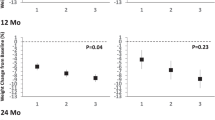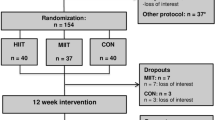Abstract
OBJECTIVE: To assess the acceptance of the traditional American College of Sports Medicine (ACSM) exercise recommendation (20–60 min of vigorous exercise at least three times per week) and of the new, broader Centers for Disease Control (CDC)/ACSM physical activity recommendation (30 min of moderate intensity activities on most days of the week) in an obese population and to elucidate the implications of meeting these recommendations on weight reduction during dietary treatment.
DESIGN: Prospective dietary intervention study of 1000 kcal diet daily.
SUBJECTS: 109 obese subjects (age: 45.6±13.1 y, body mass index (BMI): 38.1±6.0 kg/m2, (Female/Male: 81/19%)
MEASUREMENTS: The time spent in moderate (3–6 MET, metabolic equivalents) and vigorous (6–10 MET) physical activities was assessed by use of the Stanford-7-Day-Physical-Activity-Recall-Questionnaire, with subsequent allocation of the subjects to one of three physical activity groups: meeting the traditional recommendation (TR), the new recommendation (NR) or neither of both (SED, sedentary subjects). Physical activity level, physical activity energy expenditure, total energy expenditure (based upon the questionnaire) and resting metabolic rate (by standard equation) were estimated at baseline. Body weight was determined at baseline and after a mean of 16.3 weeks of dietary treatment.
RESULTS: The new, broader recommendation was met by twice as many of the obese subjects (34%) as was the traditional recommendation (17%). Weight reduction at follow up (−8.2±6.5 kg, 16.3±4.3 weeks, mean±s.d.) was positively correlated with the physical activity level at baseline (r=0.49, P<0.001). Meeting either the traditional or the new recommendation was associated with greater weight loss [−11.9±8.5 kg (TR) and −10.1±6.4 kg (NR), respectively, not statistically significant (NS)] as compared to being sedentary [−6.5±5.2 kg (SED), P<0.05 vs both NR and TR].
CONCLUSIONS: Not only participation in vigorous exercise, but also regular engagement in moderate intensity physical activities, as recently recommended by the CDC/ACSM, predicts greater weight reduction during dietary treatment, compared to being sedentary. The new, broader physical activity recommendation appears to be more readily accepted by obese subjects than the former ACSM recommendation on exercise training.
This is a preview of subscription content, access via your institution
Access options
Subscribe to this journal
Receive 12 print issues and online access
$259.00 per year
only $21.58 per issue
Buy this article
- Purchase on Springer Link
- Instant access to full article PDF
Prices may be subject to local taxes which are calculated during checkout
Similar content being viewed by others
Author information
Authors and Affiliations
Rights and permissions
About this article
Cite this article
Weyer, C., Linkeschowa, R., Heise, T. et al. Implications of the traditional and the new ACSM Physical Activity Recommendations on weight reduction in dietary treated obese subjects. Int J Obes 22, 1071–1078 (1998). https://doi.org/10.1038/sj.ijo.0800728
Received:
Revised:
Accepted:
Published:
Issue Date:
DOI: https://doi.org/10.1038/sj.ijo.0800728
Keywords
This article is cited by
-
Exercise does not feel the same when you are overweight: the impact of self-selected and imposed intensity on affect and exertion
International Journal of Obesity (2006)



